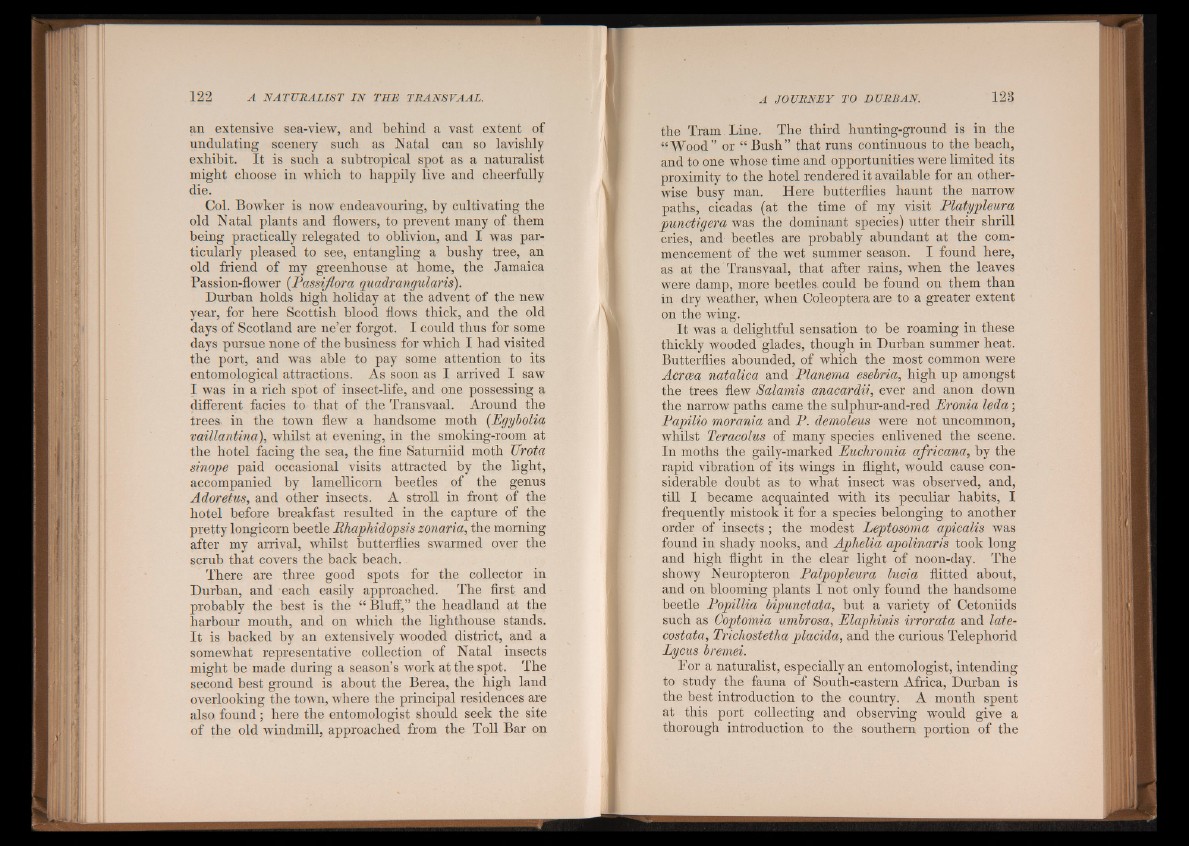
an extensive sea-view, and behind a vast extent of
undulating scenery such as Natal can so lavishly
exhibit. It is such a subtropical spot as a naturalist
might choose in which to happily live and cheerfully
die.
Col. Bowker is now endeavouring, by cultivating the
old Natal plants and flowers, to prevent many of them
being practically relegated to oblivion, and I was particularly
pleased to see, entangling a bushy tree, an
old friend of my greenhouse at home, the Jamaica
Passion-flower (Passiflora quadrangularis).
Durban holds high holiday at the advent of the new
year, for here Scottish blood flows thick, and the old
days of Scotland are ne’er forgot. I could thus for some
days pursue none of the business for which I had visited
the port, and was able to pay some attention to its
entomological attractions. As soon as I arrived I saw
I was in a rich spot of insect-life, and one possessing a
different facies to that of the Transvaal. Around the
trees- in the town flew a handsome moth (Egybolia
vaillantina), whilst at evening, in the smoking-room at
the hotel facing the sea, the fine Saturniid moth TJrota
sinope paid occasional visits attracted by the light,
accompanied by lamellicom beetles of the genus
Adoretus, and other insects. A stroll in front of the
hotel before breakfast resulted in the capture of the
pretty longicom beetle Bhaphidopsis zonaria, the morning
after my arrival, whilst butterflies swarmed over the
scrub that covers the back beach.
There are three good spots for the collector in
Durban, and each easily approached. The first and
probably the best is the “ Bluff,” the headland at the
harbour mouth, and on which the lighthouse stands.
It is backed by an extensively wooded district, and a
somewhat representative collection of Natal insects
might be made during a season’s work at the spot. The
second best ground is about the Berea, the high land
overlooking the town, where the principal residences are
also found; here the entomologist should seek the site
of the old windmill, approached from the Toll Bar on
the Tram Line. The third hunting-ground is in the
“Wood” or “ Bush” that runs continuous to the beach,
and to one whose time and opportunities were limited its
proximity to the hotel rendered it available for an otherwise
busy man. Here butterflies haunt the narroAV
paths, cicadas (at the time of my visit Platypleura
punctigera was the dominant species) utter their shrill
cries, and beetles are probably abundant at the commencement
of the wet summer season. I found here,
as at the Transvaal, that after rains, when the leaves
were damp, more beetles, could be found on them than
in dry weather, when Coleoptera are to a greater extent
on the wing.
It was a delightful sensation to be roaming in these
thickly wooded glades, though in Durban summer heat.
Butterflies abounded, of which the most common were
Acrcea natalica and Planema esebria, high up amongst
the trees flew Salamis anacardii, ever and anon down
the narrow paths came the sulphur-and-red Eronia leda;
Papilio morania and P. demoleus were not uncommon,
whilst Teracolus of many species enlivened the scene.
In moths the gaily-marked Euchromia africana, by the
rapid vibration of its wings in flight, would cause considerable
doubt as to what insect was observed, and,
till I became acquainted with its peculiar habits, I
frequently mistook it for a species belonging to another
order of insects; the modest Leptosoma apicalis was
found in shady nooks, and Aphelia apolinaris took long
and high flight in the clear light of noon-day. The
showy Neuropteron Palpopleura lucia flitted about,
and on blooming plants I not only found the handsome
beetle Popillia bipunctata, but a variety of Cetoniids
such as Coptomia umbrosa, Elapliinis irrorata and late-
costata, Trichostetha placida, and the curious Telephorid
Lycus bremei.
For a naturalist, especially an entomologist, intending
to study the fauna of South-eastern Africa, Durban is
the best introduction to the country. A month spent
at this port collecting and observing would give a
thorough introduction to the southern portion of the